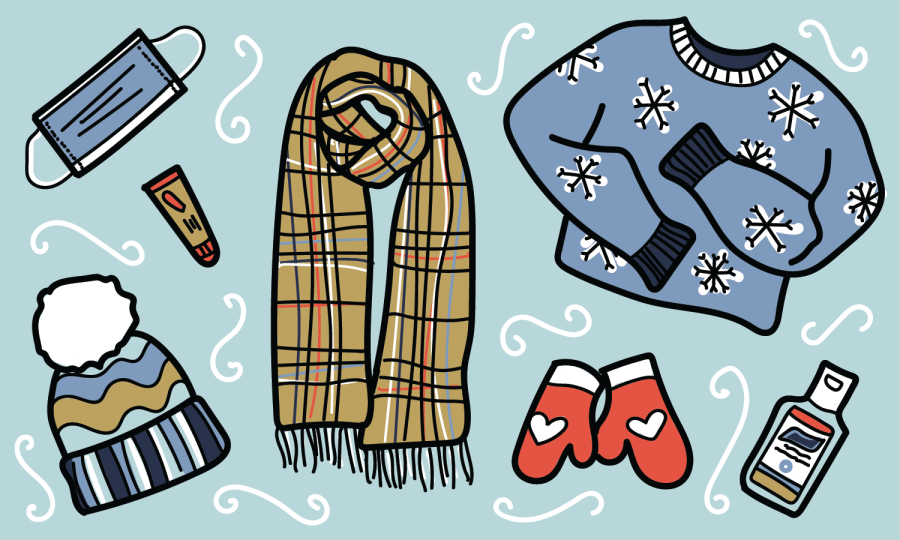COVID-19 outlook for Larimer County: What to expect
Collegian | Chloe Leline
November 14, 2022
Entering winter means entering a new respiratory season, and each year brings different challenges, especially when it comes to COVID-19.
Along with professionals, we can keep up with the virus trends and properly protect ourselves in order to help out the greater good.
“One thing that we do know with all respiratory viruses is during, you know, the fall and winter, we always see an increase, primarily … (when) it gets cold and people go indoors,” said Matt Bauer, regional epidemiologist in Larimer County.
The cold itself creates an environment where transmission is more likely to take place.
“As far as viral particles and respiratory droplets, in cold weather they linger in the air for longer than they do in warm and humid temperatures, so that also kind of helps it aid in transmission,” Bauer said.
“The most important thing that we can do is make sure that we get our flu vaccines. … Stay updated on our COVID-19 vaccine, including the omicron dose; get your flu and your omicron dose together.” -Scott Bookman, director of the division of disease control and public health response and COVID-19 incident commander of Colorado Department of Public Health and Environment
Along with influenza and respiratory syncytial virus, COVID-19 cases are expected to increase during the winter. Dr. Rachel Herlihy, state epidemiologist for the Colorado Department of Public Health & Environment, has been keeping track of the case numbers.
“Our COVID case numbers are increasing over time,” Herlihy said. “Similar to our case data where we’re seeing an increased number of cases, we’re also seeing our percent positivity value increase.”
The number of hospitalizations for respiratory viruses has been increasing — especially COVID-19.
“Our hospitalizations … as of (Nov. 9) were 320 hospitalizations in the state, and that is up from 218 just a week ago, so (that is) a pretty dramatic increase in COVID-19 hospitalizations as well,” Herlihy said.
Dr. Kevin Carney, a pediatric emergency medicine physician and the associate chief medical officer at Children’s Hospital Colorado, emphasized the impact the season is having on pediatric patients.
“Our emergency departments are seeing a record volume of patients,” Carney said. “In fact, the number of patients seeking care in our emergency departments on a daily basis has been on average 30% higher than even the busiest of days in previous respiratory seasons.”
While the numbers may be putting a lot of strain on medical personnel, they’ll continue to do their best.
“I do want to stress that while we’re experiencing higher volumes than we’ve ever seen, our team members are working tirelessly to ensure that every patient is treated with the best possible care,” Carney said.
“The most important thing that we can do is make sure that we get our flu vaccines,” said Scott Bookman, director of the division of disease control and public health response and COVID-19 incident commander with the CDPHE. “Stay updated on (your) COVID-19 vaccine, including the omicron dose; get your flu and your omicron dose together.”
“We urge everyone who can to get the COVID-19 vaccine and a flu shot,” Carney said.
The professionals also encourage proper hand hygiene, covering your mouth when you sneeze or cough and cleaning potentially contaminated services. It’s also important to stay home when you’re sick.
“We know that what can be a mild cold for one person can be very serious for someone else,” Bookman said. “We are at a point where we once again need to take every symptom incredibly seriously and make the right choice to stay home.”
Even the approaching holidays don’t mean we shouldn’t be just as careful.
“With the upcoming holidays, it’s important to be mindful of playdates, family gatherings and holiday events and to take precaution beforehand and stay home if you’re sick,” Carney said.
Another important tool to minimize the transmission of COVID-19 and other illnesses is masks.
“We learned a lot about masks through the course of the pandemic,” Herlihy said. “We know that masks are an effective strategy and an important way for individuals to decrease their risk of acquiring a respiratory infection and also can be an important way for individuals to prevent transmission from a virus they have themselves to another person.”
When taken, these small steps have the power to get the community through another respiratory season.
Reach Emmalee Krieg at news@collegian.com or on Twitter @CSUCollegian.





